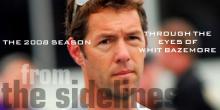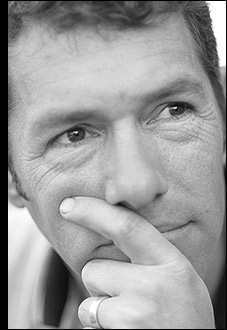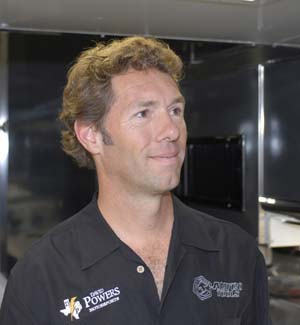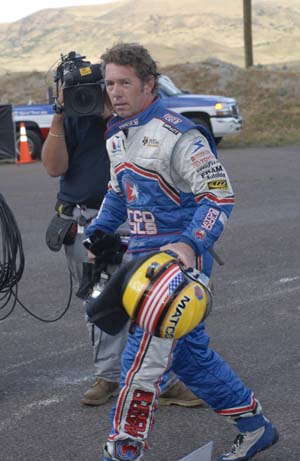WHIT BAZEMORE – WATCHING DRAG RACING FROM THE SIDELINES
 will make one a
good observer.
will make one a
good observer.For Whit Bazemore, in the lull between fighting a complex stock trading industry, he managed to get a good look at the drag racing industry from the sidelines.
Never one to mince words, and rarely within the politically correct guidelines, this former photographer turned nitro racer earned a look at the sport from the eyes of a fan, with a keen understanding of the inner circle of drag racing politics.
He’s definitely a qualified observer, who until this season was a part of the drag racing traveling circus consecutively for over three decades.
We present to you Bazemore, live and certainly plugged in.
One of Drag Racing’s Most Outspoken – Speaks …
 A year on the sidelines without the hustle and bustle of adhering to a strenuous travel regimen associated with nitro racing will make one a good observer.
A year on the sidelines without the hustle and bustle of adhering to a strenuous travel regimen associated with nitro racing will make one a good observer.
For Whit Bazemore, in the lull between fighting a complex stock trading industry, he managed to get a good look at the drag racing industry from the sidelines.
Never one to mince words, and rarely within the politically correct guidelines, this former photographer turned nitro racer earned a look at the sport from the eyes of a fan, with a keen understanding of the inner circle of drag racing politics.
He’s definitely a qualified observer, who until this season was a part of the drag racing traveling circus consecutively for over three decades.
We present to you Bazemore, live and certainly plugged in.
OUTSIDE OF OUR CIRCLE
“Not racing definitely gave me the chance to see the sport from a different perspective. I think it’s good to look at things from a different perspective when you can, because you learn more and you see many elements that you may not have noticed, because when you are racing, you are so focused on your job that it is sometimes hard to see the big picture. But the biggest thing I realized was how, when we’re in this sport, how big and important we think it is. When you are out of the sport it doesn’t take long to realize the sport really is pretty small. That was kind of something that dawned on me after a while; this is something that’s not that big. It is a very niche sport, much smaller than many other sports that you wouldn’t even think of.
“Living in Bend [Oregon] you have to find our sport. If you want results from a race you have to look hard to find them, they aren’t just out there for you to see. When the paper comes in the morning, the results just aren’t there. You have to search out NHRA drag racing. The races are basically invisible to a large extent, unless of course you are watching ESPN 2. That was an interesting and somewhat unfortunate revelation to me. Thank goodness for the Internet.
a d v e r t i s e m e n t
Click to visit our sponsor's website
TELEVISION, MY LIFELINE TO THE SPORT
“I think the television shows are very good. It’s been said a lot, and it’s true, the sport is very hard to televise. It’s very hard to capture the unbelievable excitement of fuel cars running down the race track. But one thing I think the sport needs to work on is its drama. There needs to be more drama, you know? There needs to be real rivalries, not manufactured ones and not ones that are just smack talking.
“I think that’s something NASCAR has always done really well, you go back to 1979 when the Allison brothers and Cale Yarbrough had that fight at Daytona. That was really a turning point for that sport – it captured the public’s imagination. We need less vanilla in our sport; we need people who aren’t afraid to truly say what they think. But the underlying problem is the trend has been that it’s too easy to be replaced, if you are a hired driver. So that makes everyone politically correct, and looking at the big picture I don’t think that’s a good thing. Plus, NHRA, when they decide they don’t like you, or they think you are getting out of hand, for whatever reason, life can become more expensive. It is a bad policy because it really keeps people in check, way too much in my opinion.
“You have to have a guy like Bob Vandergriff who hates to lose and throws his helmet every so often and you have to have the emotion like a Cory Mac. That kind of stuff is good, Angelle I think is good, even if tears and emotions sometimes are perceived as a weakness that can be exploited by your competitors. But there are so many out there that seem like they don’t care whether they win or lose and that comes across in a bad way on television.”
EXCITEMENT ON TELEVISION = BAZEMORE?
“They (NHRA) don’t want a Whit Bazemore out there, that’s the thing. I’m talking about the sport, the sport as a whole, it’s so politically correct and I don’t know why. It doesn’t have to be but it is. Maybe it is how Graham Light wants it.”
HOW IS 1,000 FOOT DRAG RACING?
“On TV you don’t notice it as much as I’m sure you do at the track. It didn’t really mean that much (on TV). I don’t think it was all that detrimental to the general public, but to the hardcore fan, it’s a problem. I’m pretty sure that the competitors don’t like it. The car owners do like it because it has advantages cost wise. It seems much, much cheaper. But on TV you don’t really notice it as much as I thought you would, so maybe it doesn’t matter. But I didn’t go to a race so I don’t really know. If I was still racing I can tell you I wouldn’t like it at all.”
a d v e r t i s e m e n t
Click to visit our sponsor's website
THE COUNTDOWN TO THE CHAMPIONSHIP

BEING AWAY FROM RACING AND THE FANS …
“I have a new set of challenges with what I’m trying to do to make a living. It’s really a lot like racing. It’s been a hard year obviously in the stock market. I picked a hard year to become a professional stock trader. It’s a challenge; it’s really a competition. It’s still competing; you’re just competing against the market and I like to compete. If I didn’t have that, then not racing would have been a lot more difficult for me. I’m really lucky in that regard.
“But, having said that, there are a lot of things I miss about it. I miss my friends at the track obviously; I miss the interactions with the fans because that was always special. When you’re winning, yeah it’s cool but it’s when you’re not winning that fan interaction can mean a lot. It means something when complete strangers believe in and encourage you, it can be a source of strength. You also have some people who you get to know more personally and that is cool too. It’s really kind of unique and it’s a really an amazing experience. But I also appreciate the somewhat quieter lifestyle that we have here in Oregon now.
THERE WAS A PRO LEADERSHIP OPENING EARLIER IN THE YEAR. DO YOU FEEL THEY SELECTED THE RIGHT MAN FOR THE JOB?
“My opinion means nothing, and the membership and board obviously are taking the organization where they want it to go. But, my thought is that PRO could be more, that it could have way more input into the issues facing the sport.
“I think PRO really needs someone like a Bob Vandergriff Jr. for the job. I think selecting him or someone like him would have been a benefit to the organization. Someone with a very good understanding of the marketing side of the sport and someone not afraid to get things done or bring much needed new ideas to the table. What are the real weaknesses of the sport and what are the fixes? The goal of the organization should always be to make its members as successful as they can possibly be. It should also assist in making the sport as healthy as it can be. The group should be able to assist in getting all the numbers increased whether it’s the purses, the attendance at the races and if need be the television numbers. Adding to that, PRO should be able to assist in bringing in and more importantly, helping keep marketing and sponsorship dollars in the sport.
When I was racing, I felt this was an area that PRO could focus on and concentrate more effort on. It seems like now the organization has traveled down a more technical road, especially with the recent hiring of Ray Alley, who is an excellent choice for the technical side of things. It’s obvious they are more concerned with the small details such as the size of gravel in the sand traps.
“Don’t get me wrong, all of that is important, but there is a bigger picture that needs looking at as well. There are a lot of issues that haven’t necessarily been addressed enough in the past.”
a d v e r t i s e m e n t
Click to visit our sponsor's website
DOES PRO ACTUALLY WIELD ANY POWER?
“You have to have healthy teams in order to have a healthy sport, that’s first and foremost. If the teams aren’t financially healthy then the sport is going to suffer, the show is going to suffer and you’re not going to be able to build the sport the way it should be built. So, to me, the first priority is to make teams as financially healthy as they can possibly be. From that point more good things happen. The show is a lot better, you have more fans watching because they love the show, and you build the ratings on TV because the show is better. You can build more interest and have more people making better money through the sport. When the teams are healthy then the entire sport’s economy is stronger.
“That’s what I think a very strong PRO organization should be able to accomplish, they should be able to make the sport a much, much better place for the teams and the participants. Not only to the Top Fuel, Funny Car and Pro Stock guys, but everyone. Because when those areas are healthy the benefits always trickle down all the way to the sportsman racers.
WATCHING TONY SCHUMACHER’S TOTAL DOMINATION …
“I was glad that I wasn’t racing Top Fuel this year, that’s for sure! It was an extremely remarkable season they had. Tony is a really, really good driver. You know Alan Johnson is a crew chief who’s certainly one of the best if not the best ever in the sport. You have to look at Austin Coil and Alan Johnson as the two top guys to ever tune a Fuel car. Which one is better, I could never tell you. But from a driver standpoint, Tony is a really good driver under pressure. In the Fuel ranks, especially Funny Car, you saw some guys fail in huge ways under pressure this year, but not Tony Schumacher. You can say what you want about Tony, but he’s worked hard to turn himself into a driver who quite honestly doesn’t make very many mistakes.”
a d v e r t i s e m e n t
Click to visit our sponsor's website
WAYS TO IMPROVE THE SPORT LOOKING FROM THE OUTSIDE …

“I think there are a number of areas that quite honestly can be looked at. The first priority, in my opinion, is the health of the teams. Times have changed, and now the NHRA must, absolutely must, roll out the red carpet to every single corporate sponsor involved in the sport. For example, it’s unconscionable that these other energy drink companies were not really invited to stay involved. According to one person involved, the marketing limits suddenly placed on those companies made an involvement not worth staying. The same thing can be said for the armed services with the Army.
“A couple of years ago we were trying to bring in another branch of the Armed Services but it was just so limiting, marketing wise and on site, what they could do at that time, because the NHRA had sold an exclusive to the Army. It was very limiting, and quite frankly, the sport is not in a position of strength where the NHRA can dictate who plays and who doesn’t. The PRO should and could fix the thought process there. So I think the sport kind of shoots itself in the foot in that regard because you have teams now that don’t have sponsorships i.e. Jerry Tolliver and the Monster deal which really struggled anyway. To have those types of companies not coming back is bad.
“We have to have the sport where it gives the most value possible to all the sponsors and to me that has to become a priority. If it already is a priority then I don’t think it’s been very successful given the economics that we’re in and who we’ve seen go out the door. You can’t have people going out the door for some of the reasons that they’ve left, you just can’t. That really has to be worked on.
“Then the safety aspect always has to be looked at. I think some of the priorities are wrong. For example, I don’t really agree with this remote control shut off device. I don’t think you should have a guy on the starting line who can drive the car at all in any way, shape or form. I think you have a guy who drives the car and he drives it for a reason, because they are the best person available. Period. Any other reason affects the credibility of the sport. The driver has to make the decision when to shut the car off and if the driver can’t make that decision then you really need to get a new driver. A lot of this is coming up because of Scott Kalitta’s accident but that car blew up and once it had its problem, the new device wouldn’t have helped it. What I’m trying to say is being able to shut the car off from the starting line wouldn’t have changed that run or the outcome at all. And the argument about stuck throttles is, in my opinion, BS. We had a throttle stick one night with the DSR Funny Car testing before Indy one year, and we got the car stopped in plenty of time with no fire. The thing went 340 - 350mph or more, way past the finish line, so it can be done. It was a little crazy, but it happens and you have to expect it, train your mind for it, and do the right thing.
“But what would have changed Scott’s outcome is having the race track built to a certain specification that is enforced and not having poles that you can hit and not having boom cranes in the shutdown area. If those things hadn’t have been there the outcome of that crash would’ve been better. That’s where I think the sport needs to take a closer look: at the race tracks and specs. I know they’re working on this stuff but still, things aren’t getting done quickly enough. I recently read how Bob Vandergriff is still frustrated over the light poles and scoreboards. The people in control were made aware of my own personal concerns after Houston ’07 regarding scoreboards and poles. But after a year, nothing was fixed. So it is like beating a dead horse, and you realize they really, truly do not care. Let me tell you, it is extremely frustrating when reality sets in.
I agree whole heartedly, those are the real issues, you have to make the race tracks safer and some of the race car issues, like Force’s improvements, those are all great improvements. I think there are some other areas that are a little misaligned, like having the remote shutoff, I disagree with that.
“They have things like throttle stops for burnouts, they just make it to where it’s so easy to drive the cars now and anybody can do it. It takes away from the sport; I think we should get rid of those. The cars should be harder to drive, the driver should have to do more on a run, things that are now controlled in a mechanical way should be driver operated.
Qualifying is very boring to watch on TV. There is not much drama, and people smoke the tires all the time and shut off. It is boring as hell. So what if you combined all 4 qualifying runs to determine your position? No one would shut off on a tire smoker, and there would be a premium on being a great driver who can recover a car. It would be way, way more exciting in person and on TV. It is a big change, more costly for sure, but in the end would it help grow the sport and therefore ultimately benefit the teams? I believe the answer is yes. The good drivers would bring more credibility to the sport and that is a good thing. Making the cars harder to drive would help the sport, I believe. For sure it would benefit the drivers, well not the bad ones, they would go away.
WATCHING SCOTT KALITTA’S CRASH …
“Scott’s accident to me was very frustrating; because if certain people had listened, then he still might be here today. You can’t make the sport 100% safe – and you don’t want to because racing is not about being risk free, it’s risk. That’s part of what racing is. But having said that, the sport still needs to address the obvious. You have to fix the obvious and our sport doesn’t always do that. That’s what is frustrating.”
| {loadposition feedback} |






